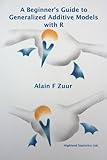A beginner's guide to generalized additive models with R Alain F. Zuur
Tipo de material: Libro
impreso(a)
Idioma: Inglés Detalles de publicación: Newburgt, United Kingdom Highland Statistics Ltd. 2012Descripción: xii, 194 páginas fotografías, ilustraciones 23 centímetrosISBN:
Libro
impreso(a)
Idioma: Inglés Detalles de publicación: Newburgt, United Kingdom Highland Statistics Ltd. 2012Descripción: xii, 194 páginas fotografías, ilustraciones 23 centímetrosISBN: - 0957174128
- 9780957174122
- 519.50285 Z9
Incluye bibliografía: páginas 185-188 e índice
Preface.. Acknowledgements.. Datasets used in this book.. Cover art.. Contributors.. 1 Review of multiple linear regression.. 1.1 Light levels and size of the human visual system.. 1.2 The variables.. 1.3 A protocol for the analysis.. 1.4 Data exploration.. 1.5 Multiple linear regression.. 1.5.1 Underlying statistical theory.. 1.5.2 Multiple linear regression.. 1.5.3 Fitting the model in R and estimated parameters.. 1.6 Finding the optimal model.. 1.7 Degrees of freedom.. 1.8 Model validation.. 1.9. Model interpretation.. 1.10 What happens if we use collinear covariates?.. 1.11 Should we have applied a mixed effects model?.. 1.12 What to do if things go wrong.. 1.13 What to present in a paper.. 2 Introduction to additive models using deep-sea fisheries data.. 2.1 Impact of deep-sea fisheries.. 2.2 First encounter with smoothers.. 2.2.1 Applying linear regression.. 2.2.2 Applying cubic polynomials.. 2.2.3 A simple GAM.. 2.2.4 Moving average and LOESS smoothers.. 2.3 Applying GAM in R using the mgcv package.. 2.4 Cross-validation.. 2.5 Model validation.. 2.5.1 Normality and homogeneity.. 2.5.2 Independence.. 2.6 Extending the GAM with more covariates.. 2.6.1 GAM with a smoother and a nominal covariate.. 2.6.2 GAM with an interaction term; first implementation.. 2.6.3 GAM with an interaction term; second implementation.. 2.6.4 GAM with an interaction term; third implementation.. 2.7 Transforming the density data.. 2.8 Allowing for heterogeneity.. 2.9 Transforming and allowing for heterogeneity.. 2.10 What to present in a paper.. 3 Technical aspects of GAM using pelagic bioluminescent organisms.. 3.1 Pelagic bioluminescent organism data.. 3.2 Linear regression.. 3.3 Polynomial regression model.. 3.4. Linear spline regression.. 3.5 Quadratic spline regression.. 3.6 Cubic regression splines.. 3.7 The number of knots.. 3.8 Penalized quadratic spline regression.. 3.9 Other smoothers.. 3.10 Cubic smoothing spline
3.11 Summary of smoother types.. 3.12 Degrees of freedom of a smoother*.. 3.13 Bias-variance trade-off.. 3.14 Confidence intervals.. 3.15 Using the function gam in mgcv.. 3.16 The danger of using GAM.. 3.17 Additive models with multiple smoothers.. 4 Introducing generalized additive models using deep-sea fishery data.. 4.1 From additive models to generalized additive models.. 4.2 Review of GLM.. 4.2.1 Distribution.. 4.2.2 Predictor function.. 4.2.3 Link function.. 4.3 Start with GLM or GAM?.. 4.4 Results of Poisson and negative binomial GLM.. 4.5 Using the offset in a GLM or GAM.. 4.6 Poisson GLM with offset.. 4.7 Negative binomial GLM with offset.. 4.8 Poisson and negative binomial GAM with offset.. 4.9 What to present in paper.. 5 Additive modelling applied on stable isotope ratios of ocean squid.. 5.1 Stable isotope ratios of squid.. 5.2 The variables.. 5.3 Data exploration.. 5.4 Brainstorming.. 5.5 Applying the multiple linear regression model.. 5.6 Applying an additive model.. 5.7 Testing linearity versus non-linearity.. 5.7.1 Programming a smoother manually**.. 5.7.2 Summary of the mathematics.. 5.8 Consequences of ignoring collinearity in the additive model.. 5.9 Discussion.. 5.10 What to present in a paper.. 6 Generalized Additive Models applied on northern gannets.. 6.1 Northern gannets in the North Sea.. 6.2 The variables.. 6.3 Brainstorming.. 6.4 Data exploration.. 6.5 Building up the complexity of the GAMs.. 6.6 Zero-inflated GAM.. 6.6.1 A zero-inflated model for the gannet data.. 6.6.2 ZIP GAM using gamlss.. 6.7 Discussion.. 6.8 What to present in a paper.. 7 Generalized Additive Models applied on parasites of Argentine hake.. 7.1 Parasites of Argentine hake in the Argentine Sea.. 7.2 The variables.. 7.3 Data exploration.. 7.4 Brainstorming.. 7.5 Applying binomial GAM.. 7.6 Discussion.. 7.7 What to present in a paper.. References.. Index
A Beginner's Guide to Generalized Additive Models with R is, as the title implies, a practical handbook for the non-statistician. The author's philosophy is that the shortest path to comprehension of a statistical technique without delving into extensive mathematical detail is through programming its basic principles in, for example, R. Beginner's Guide to GAM Not a series of cookbook exercises, the author uses data from biological studies to go beyond theory and immerse the reader in real-world analysis with its inherent untidiness and challenges. The book begins with a review of multiple linear regression using research on human crania size and ambient light levels and continues with an introduction to additive models based on deep sea fishery data. Research on pelagic bioluminescent organisms demonstrates simple linear regression techniques to program a smoother. In Chapter 4 the deep sea fishery study is revisited for a discussion of generalized additive models. The remaining chapters present detailed case studies illustrating the application of Gaussian, Poisson, negative binomial, zero-inflated Poisson, and binomial generalized additive models using seabird, squid, and fish parasite studies. Inglés


